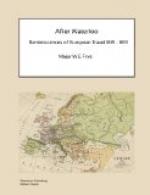FERRARA.
On the 9th of May I set out from Florence on my journey hither. Two days’ journey brought me to Bologna where I stopped one day; and the following day I reached this place (Ferrara), six miles distant from Bologna. The country between these two cities is a perfect plain and very fertile. At Malalbergo (half-way) We crossed the Reno in a boat. I put up at the Tre Mori in Ferrara. Having remained two and half days here I have had time to inspect and examine almost everything of consequence that the city affords. The city itself has an imposing, venerable appearance and can boast of some fine buildings; yet with all this there is an air of melancholy about it. It is not peopled in proportion to its size and grass is seen growing in several of the streets. I believe the unhealthiness of the environing country is the cause of the decrease of population, for Ferrara lies on a marshy plain, very liable to inundation In the centre of the city stands the ancient Palace of the Dukes of Ferrara, a vast Gothic edifice, square, and flanked with round towers, and a large court-yard in the centre. It was in this court-yard that Hugo and Parisina were decapitated. From the top of this palace a noble view of the plain of the Po represents itself, and you see the meanderings of that King of Rivers, as the Italian poets term it. As the Po runs thro’ a perfectly flat country, and is encreased and swollen by the torrents from the Alps and Appennines that fall into the smaller rivers, which unite their tributary streams with the Po and accompany him as his seguaci to the Adriatic, this country is liable to the most dreadful inundations: flocks and herds, farm-houses and sometimes whole villages are swept away. Dykes, dams and canals innumerable are in consequence constructed throughout this part of the country, to preserve it as much as possible from such calamities. Ariosto’s description of an over-flowing of this river is very striking, and I here transcribe it:
Con quel furor che il Re de’ fiumi
altero,
Quando rompe tal volta argine e sponda,
E che ne’ campi Ocnei si apre il
sentiero,
E i grassi solchi e le biade feconde,
E con le sue capanne il gregge intero,
E co’ cani i pastor porta neil’
onde, etc.[118]
Even with that rage wherewith the stream
that reigns,
The king of rivers—when
he breaks his mound.
And makes himself a way through Mantuan
plains—
The greasy furrows and glad
harvests, round,
And, with the sheepcotes, nock, and dogs
and swains
Bears off, in his o’erwhelming
waters drowned.
—Trans. W.S. ROSE.




